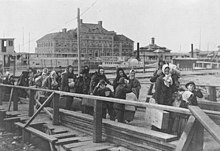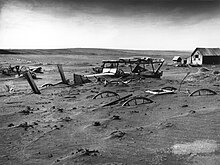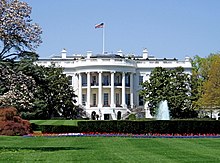United States
From jeena
(Redirected from US)
This article is about the United States of America. For other uses of terms redirecting here, see US (disambiguation), USA (disambiguation), and United States (disambiguation).
| United States of America | ||||||
|---|---|---|---|---|---|---|
|
||||||
| Motto: In God We Trust (official) E Pluribus Unum (traditional) (Latin: Out of Many, One) |
||||||
| Anthem: "The Star-Spangled Banner" |
||||||
 |
||||||
| Capital | Washington, D.C. 38°53′N 77°01′W |
|||||
| Largest city | New York City | |||||
| Official language(s) | None at federal level[a] | |||||
| National language | English (de facto)[b] | |||||
| Demonym | American | |||||
| Government | Federal presidential constitutional republic, Two-party system |
|||||
| - | President | Barack Obama (D) | ||||
| - | Vice President | Joe Biden (D) | ||||
| - | Speaker of the House | John Boehner (R) | ||||
| - | Chief Justice | John Roberts | ||||
| Legislature | Congress | |||||
| - | Upper house | Senate | ||||
| - | Lower house | House of Representatives | ||||
| Independence | from the Kingdom of Great Britain | |||||
| - | Declared | July 4, 1776 | ||||
| - | Recognized | September 3, 1783 | ||||
| - | Current constitution | June 21, 1788 | ||||
| Area | ||||||
| - | Total | 9,826,675 km2 [1][c](3rd/4th) 3,794,101 sq mi |
||||
| - | Water (%) | 6.76 | ||||
| Population | ||||||
| - | 2012 estimate | 314,310,000[2] (3rd) | ||||
| - | Density | 33.7/km2 87.4/sq mi |
||||
| GDP (PPP) | 2011 estimate | |||||
| - | Total | $15.094 trillion[3] (1st) | ||||
| - | Per capita | $48,386[3] (6th) | ||||
| GDP (nominal) | 2011 estimate | |||||
| - | Total | $15.094 trillion[3] (1st) | ||||
| - | Per capita | $48,386[3] (15th) | ||||
| Gini (2007) | 45.0[1] (39th) | |||||
| HDI (2011) | ||||||
| Currency | United States dollar ($) (USD) |
|||||
| Time zone | (UTC−5 to −10) | |||||
| - | Summer (DST) | (UTC−4 to −10[e]) | ||||
| Date formats | m/d/yy (AD) | |||||
| Drives on the | right | |||||
| ISO 3166 code | US | |||||
| Internet TLD | .us .gov .mil .edu | |||||
| Calling code | +1 | |||||
| ^
a. English is the official language of at least 28 states—some sources
give higher figures, based on differing definitions of "official".[5] English and Hawaiian are both official languages in the state of Hawaii.
^ b. English is the de facto
language of American government and the sole language spoken at home by
80 percent of Americans age five and older. Spanish is the second most commonly spoken language. ^ c. Whether the United States or China is larger is disputed. The figure given is from the U.S. Central Intelligence Agency's The World Factbook. Other sources give smaller figures. All authoritative calculations of the country's size include only the 50 states and the District of Columbia, not the territories. ^ d. The population estimate includes people whose usual residence is in the fifty states and the District of Columbia, including noncitizens. It does not include either those living in the territories, amounting to more than 4 million U.S. citizens (mostly in Puerto Rico), or U.S. citizens living outside the United States. ^ e. See Time in the United States for details about laws governing time zones in the United States. ^ f. Does not include Insular areas and United States Minor Outlying Islands, which have their own ISO 3166 codes. |
||||||
Paleoindians migrated from Asia to what is now the United States mainland around 15,000 years ago. The Native American population descendent from them was in turn greatly reduced, primarily by disease after European contact and exasperated by European colonization. The United States itself was initially derived from thirteen British colonies located along the Atlantic seaboard. On July 4, 1776, delegates to the Continental Congress issued the Declaration of Independence, which proclaimed their right to self-determination and establishment of a sovereign union. The rebellious states defeated the British Empire in the American Revolution, the first successful colonial war of independence.[7] The current United States Constitution was adopted on September 17, 1787; its ratification the following year made the states part of a single republic with a stronger central government. The Bill of Rights, consisting of ten constitutional amendments guaranteeing many fundamental civil rights and freedoms, was ratified in 1791.
Through the 19th century, the United States embarked on a vigorous program of expansion across North America. It displaced native tribes, acquiring the Louisiana territory from France and Florida from Spain. It annexed the Republic of Texas in 1845, leading to war in which it conquered half of Mexico. It purchased Alaska from Russia in 1867. During the early territorial expansion, significant disputes between the agrarian slave-holding South and free-soil industrial North led to the American Civil War. The North's victory reestablished the Union, and led to the ratification of the Thirteenth Amendment to the United States Constitution, ending legalized slavery in the United States. The Plains Indian Wars relocated remaining tribes onto confined reservations, a Congressional Resolution annexed the Republic of Hawaii, then the treaty ending the Spanish-American War ceded Puerto Rico and Guam. By the end of the nineteenth century, its national economy was the world's largest.[8]
The Spanish–American War and World War I confirmed the country's status as a global military power. The United States emerged from World War II as the first country with nuclear weapons and a permanent member of the United Nations Security Council. The end of the Cold War and the dissolution of the Soviet Union left the United States as the sole superpower. The U.S. economy is the world's largest national economy, with an estimated 2011 GDP of $15.1 trillion (22% of nominal global GDP and over 19% of global GDP at purchasing-power parity).[3][9] Per capita income is the world's sixth-highest.[3] The country accounts for 41% of global military spending,[10] and is a leading economic, political, and cultural force in the world.[11]
Contents
|
Etymology
See also: Names for United States citizens
In 1507, German cartographer Martin Waldseemüller produced a world map on which he named the lands of the Western Hemisphere "America" after Italian explorer and cartographer Amerigo Vespucci.[12]The first documentary evidence of the phrase "United States of America" was in an anonymously written essay published in the Virginia Gazette newspaper in Williamsburg, Virginia on April 6, 1776.[13][14] In June 1776, Thomas Jefferson included the phrase "UNITED STATES OF AMERICA" in all capitalized letters in the headline of his “original Rough draught” of the Declaration of Independence.[15][16] In the final Fourth of July version of the Declaration, the pertinent section of the title was changed to read, "The unanimous Declaration of the thirteen united States of America".[17]
On November 15, 1777, the Second Continental Congress adopted the Articles of Confederation, which states, "The Stile of this Confederacy shall be 'The United States of America'." The Franco-American treaties of 1778 used "United States of North America", but from July 11, 1778, "United States of America" was used on the country's bills of exchange, and it has been the official name ever since.[18]
The short form "United States" is also standard. Other common forms include the "U.S.", the "USA", and "America". Colloquial names include the "U.S. of A." and, internationally, the "States". "Columbia", a name popular in poetry and songs of the late 1700s,[19] derives its origin from Christopher Columbus; it appears in the name "District of Columbia".
The standard way to refer to a citizen of the United States is as an "American". Although "United States" is the official appositional term, "American" and "U.S." are more commonly used to refer to the country adjectivally ("American values", "U.S. forces"). "American" is rarely used in English to refer to subjects not connected with the United States.[20]
The phrase "United States" was originally treated as plural—e.g., "the United States are"—including in the Thirteenth Amendment to the United States Constitution, ratified in 1865. It became common to treat it as singular—e.g., "the United States is"—after the end of the Civil War. The singular form is now standard; the plural form is retained in the idiom "these United States".[21]
History
Main article: History of the United States
Native American and European settlement
The indigenous peoples of the U.S. mainland, including Alaska Natives, are believed to have migrated from Asia, beginning between 40,000 and 12,000 years ago.[22] Some, such as the pre-Columbian Mississippian culture, developed advanced agriculture, grand architecture, and state-level societies. After Europeans began settling the Americas, many millions of indigenous Americans died from epidemics of imported diseases such as smallpox.[23] The whole of what is today described as the "U.S. mainland" was once the land of the indigenous peoples.
In 1674, the Dutch ceded their American territory to England; the province of New Netherland was renamed New York.[30] Many new immigrants, especially to the South, were indentured servants—some two-thirds of all Virginia immigrants between 1630 and 1680.[31] By the turn of the 18th century, African slaves were becoming the primary source of bonded labor in many regions.[32] With the 1729 division of the Carolinas and the 1732 colonization of Georgia, the thirteen British colonies that would become the United States of America were established.[33] All had local governments with elections open to most free men, with a growing devotion to the ancient rights of Englishmen and a sense of self-government stimulating support for republicanism. All legalized the African slave trade.[34] With high birth rates, low death rates, and steady immigration, the colonial population grew rapidly. The Christian revivalist movement of the 1730s and 1740s known as the Great Awakening fueled interest in both religion and religious liberty. In the French and Indian War, British forces seized Canada from the French, but the francophone population remained politically isolated from the southern colonies. Excluding the Native Americans, who were being displaced, those thirteen colonies had a population of 2.6 million in 1770, about one-third that of Britain; nearly one in five Americans were black slaves.[35] Though subject to British taxation, the American colonials had no representation in the Parliament of Great Britain.
Independence and expansion

After the British defeat by American forces assisted by the French and Spanish, Great Britain recognized the independence of the United States and the states' sovereignty over American territory west to the Mississippi River.[39] Those wishing to establish a strong federal government with powers of taxation organized a constitutional convention in 1787.[40] The United States Constitution was ratified in 1788, and the new republic's first Senate, House of Representatives, and president—George Washington—took office in 1789.[41] The Bill of Rights, forbidding federal restriction of personal freedoms and guaranteeing a range of legal protections, was adopted in 1791.[41]
Attitudes toward slavery were shifting; a clause in the Constitution protected the Atlantic slave trade only until 1808.[42] The Northern states abolished slavery between 1780 and 1804, leaving the slave states of the South as defenders of the "peculiar institution".[43] The Second Great Awakening, beginning about 1800, made evangelicalism a force behind various social reform movements, including abolitionism.[44]

Civil War and industrialization


World War I, Great Depression, and World War II


Cold War and protest politics

The 1961 Soviet launch of the first manned spaceflight prompted President John F. Kennedy's call for the United States to be first to land "a man on the moon", achieved in 1969. Kennedy also faced a tense nuclear showdown with Soviet forces in Cuba. Meanwhile, the United States experienced sustained economic expansion. A growing civil rights movement, symbolized and led by African Americans such as Rosa Parks and Martin Luther King, Jr., used nonviolence to confront segregation and discrimination. Following Kennedy's assassination in 1963, the Civil Rights Act of 1964 and Voting Rights Act of 1965 were passed under President Lyndon B. Johnson.[71][72] He also signed into law the Medicare and Medicaid programs.[73] Johnson and his successor, Richard Nixon, expanded a proxy war in Southeast Asia into the unsuccessful Vietnam War. A widespread countercultural movement grew, fueled by opposition to the war, black nationalism, and the sexual revolution. Betty Friedan, Gloria Steinem, and others led a new wave of feminism that sought political, social, and economic equality for women.
As a result of the Watergate scandal, in 1974 Nixon became the first U.S. president to resign, to avoid being impeached on charges including obstruction of justice and abuse of power. The Jimmy Carter administration of the late 1970s was marked by stagflation and the Iran hostage crisis. The election of Ronald Reagan as president in 1980 heralded a rightward shift in American politics, reflected in major changes in taxation and spending priorities. His second term in office brought both the Iran-Contra scandal and significant diplomatic progress with the Soviet Union. The subsequent Soviet collapse ended the Cold War.
Contemporary era

On September 11, 2001, al-Qaeda terrorists struck the World Trade Center in New York City and The Pentagon near Washington, D.C., killing nearly three thousand people. In response, the Bush administration launched the global War on Terror, invading Afghanistan and removing the Taliban government and al-Qaeda training camps. Taliban insurgents continue to fight a guerrilla war. In 2002, the Bush administration began to press for regime change in Iraq on controversial grounds.[75] Forces led by the U.S. invaded Iraq in 2003, ousting Saddam Hussein. In 2005, Hurricane Katrina caused severe destruction along much of the Gulf Coast, devastating New Orleans. In 2008, amid a global economic recession, the first African American president, Barack Obama, was elected. Major health care and financial system reforms were enacted two years later. In 2011, a raid by Navy SEALs in Pakistan killed al-Qaeda leader Osama bin Laden. The Iraq War officially ended with the pullout of the remaining U.S. troops from the country in December 2011.
Government and politics

Main articles: Federal government of the United States, state governments of the United States, and elections in the United States
The United States is the world's oldest surviving federation. It is a constitutional republic and representative democracy, "in which majority rule is tempered by minority rights protected by law".[76] The government is regulated by a system of checks and balances defined by the U.S. Constitution, which serves as the country's supreme legal document.[77] In the American federalist system, citizens are usually subject to three levels of government, federal, state, and local; the local government's duties are commonly split between county and municipal governments. In almost all cases, executive and legislative officials are elected by a plurality vote of citizens by district. There is no proportional representation at the federal level, and it is very rare at lower levels.
- Legislative: The bicameral Congress, made up of the Senate and the House of Representatives, makes federal law, declares war, approves treaties, has the power of the purse,[78] and has the power of impeachment, by which it can remove sitting members of the government.[79]
- Executive: The president is the commander-in-chief of the military, can veto legislative bills before they become law (subject to Congressional override), and appoints the members of the Cabinet (subject to Senate approval) and other officers, who administer and enforce federal laws and policies.[80]
- Judicial: The Supreme Court and lower federal courts, whose judges are appointed by the president with Senate approval, interpret laws and overturn those they find unconstitutional.

The state governments are structured in roughly similar fashion; Nebraska uniquely has a unicameral legislature.[84] The governor (chief executive) of each state is directly elected. Some state judges and cabinet officers are appointed by the governors of the respective states, while others are elected by popular vote.
The original text of the Constitution establishes the structure and responsibilities of the federal government and its relationship with the individual states. Article One protects the right to the "great writ" of habeas corpus, and Article Three guarantees the right to a jury trial in all criminal cases. Amendments to the Constitution require the approval of three-fourths of the states. The Constitution has been amended twenty-seven times;[85] the first ten amendments, which make up the Bill of Rights, and the Fourteenth Amendment form the central basis of Americans' individual rights. All laws and governmental procedures are subject to judicial review and any law ruled in violation of the Constitution is voided. The principle of judicial review, not explicitly mentioned in the Constitution, was declared by the Supreme Court in Marbury v. Madison (1803).[86]
Parties and ideology
Main articles: Politics of the United States and Political ideologies in the United States

Within American political culture, the Republican Party is considered center-right or conservative and the Democratic Party is considered center-left or liberal.[88] The states of the Northeast and West Coast and some of the Great Lakes states, known as "blue states", are relatively liberal. The "red states" of the South and parts of the Great Plains and Rocky Mountains are relatively conservative.
The winner of the 2008 presidential election, Democrat Barack Obama, is the 44th U.S. president. The 2010 midterm elections saw the Republican Party take control of the House and make gains in the Senate, where the Democrats retain the majority. In the 112th United States Congress, the Senate consists of 51 Democrats, two independents who caucus with the Democrats, and 47 Republicans; the House consists of 242 Republicans and 192 Democrats—one seat is vacant. There are 29 Republican and 20 Democratic state governors, as well as one independent.[89]
Since the founding of the United States until 2000s, the country had been governed by White Anglo-Saxon Protestants (WASPs). However, the situation has changed recently and of the top 17 positions (four national candidates of the two major party in US presidential election 2012, four leaders in 112th United States Congress, and nine Supreme Court Justices) there is only one WASP.[90][91][92]
Foreign relations and military
Main articles: Foreign relations of the United States, Foreign policy of the United States, and United States Armed Forces

The United States has a "special relationship" with the United Kingdom[94] and strong ties with Canada,[95] Australia,[96] New Zealand,[97] the Philippines,[98] Japan,[99] South Korea,[100] Israel,[101] and several European countries like France and Germany. It works closely with fellow NATO members on military and security issues and with its neighbors through the Organization of American States and free trade agreements such as the trilateral North American Free Trade Agreement with Canada and Mexico. In 2008, the United States spent a net $25.4 billion on official development assistance, the most in the world. As a share of America's large gross national income (GNI), however, the U.S. contribution of 0.18% ranked last among twenty-two donor states. By contrast, private overseas giving by Americans is relatively generous.[102]

Military service is voluntary, though conscription may occur in wartime through the Selective Service System.[104] American forces can be rapidly deployed by the Air Force's large fleet of transport aircraft, the Navy's eleven active aircraft carriers, and Marine Expeditionary Units at sea with the Navy's Atlantic and Pacific fleets. The military operates 865 bases and facilities abroad,[105] and maintains deployments greater than 100 active duty personnel in 25 foreign countries.[106] The extent of this global military presence has prompted some scholars to describe the United States as maintaining an "empire of bases".[107]
Total U.S. military spending in 2010, almost $700 billion, was 43% of global military spending and greater than the next fourteen largest national military expenditures combined. At 4.8% of GDP, the rate was the second-highest among the top fifteen military spenders, after Saudi Arabia.[108] The proposed base Department of Defense budget for 2012, $553 billion, is a 4.2% increase over 2011; an additional $118 billion is proposed for the military campaigns in Iraq and Afghanistan.[109] The last American troops serving in Iraq departed in December 2011;[110] 4,484 servicemen were killed during the Iraq War.[111] Approximately 90,000 U.S. troops were serving in Afghanistan as of April 2012;[112] as of April 4, 1,924 had been killed during the War in Afghanistan.[113]



No comments:
Post a Comment